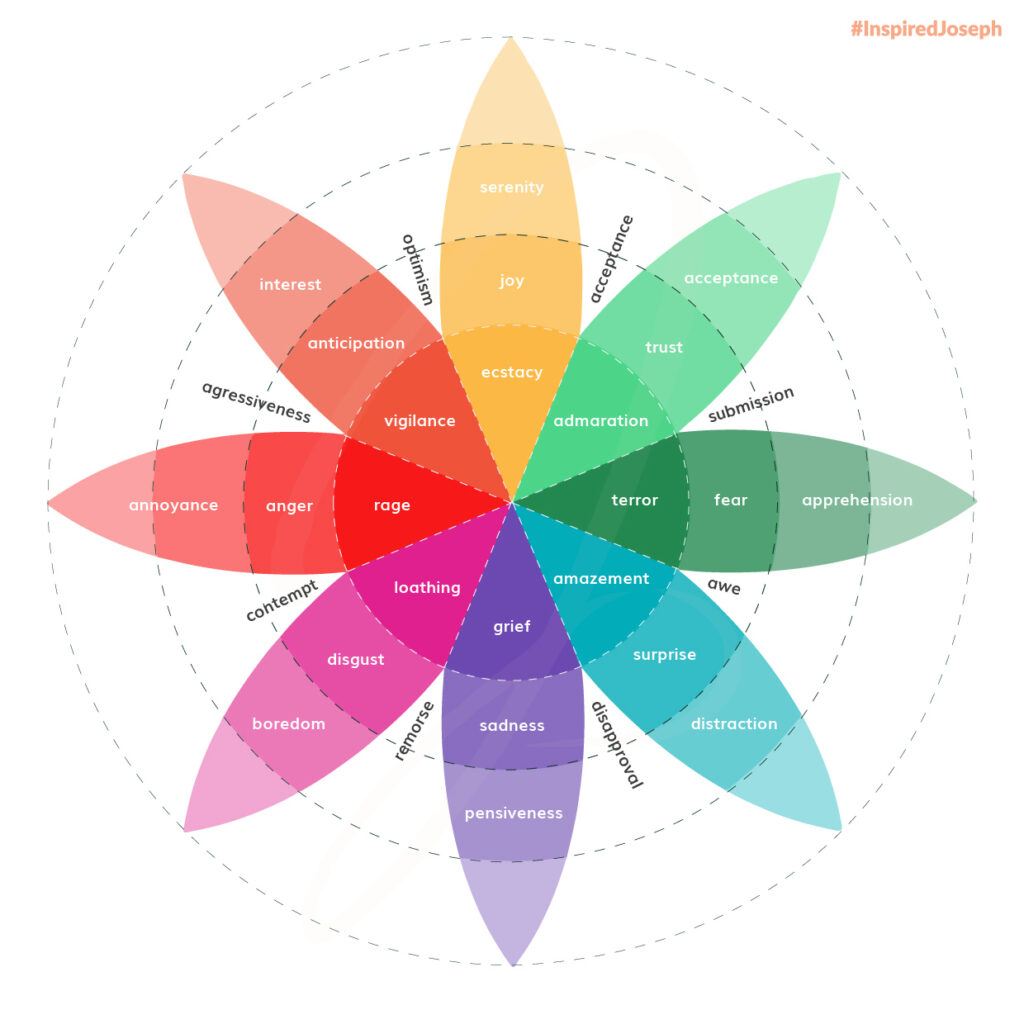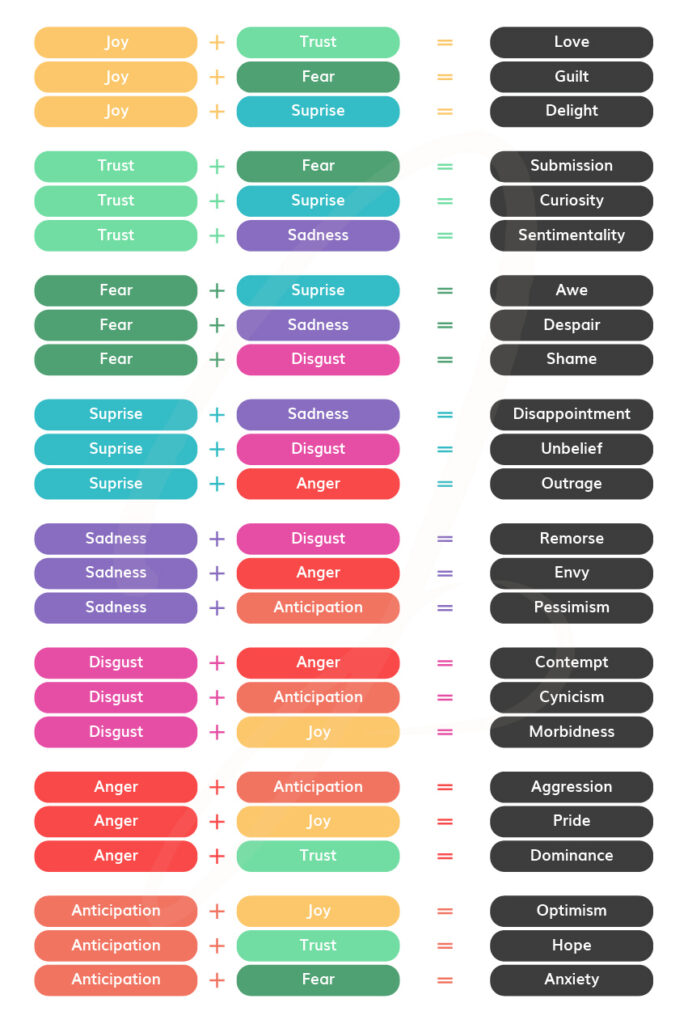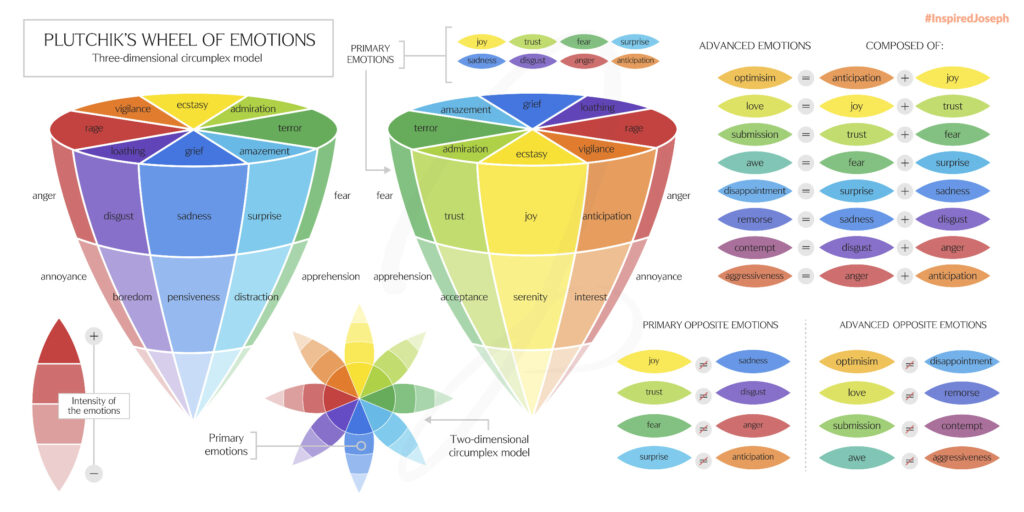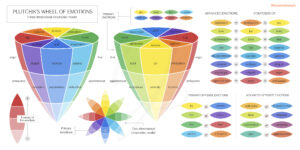The Emotion Wheel: Everything to know
The 8 core emotions by Robert Plutchik
Can you define what emotions are you feeling right now?
Have you ever had a strong emotion yet continued to struggle to come up with a means to put your thoughts into words? Perhaps you had a bad break up or had a bad news and are having problems digesting the combination of rage, sorrow, sadness, and other feelings you are experiencing.
The Nature of Emotions
Emotions prepare us to react to actual or imagined environmental stimuli (e.g., being chased by a tiger or thinking that a boss is angry can produce fear, causing us to retreat). But what is the difference between an emotion and a mood? Emotions differ because they only last for a few seconds or minutes, while moods can last for hours or even days. In addition to eliciting a series of coordinated reactions, emotions also create a collection of such responses.
Plutchik’s Emotion Wheel
Robert Plutchik developed the Emotion Wheel as a tool to assist in the classification of human feelings and help in self-awareness and understanding. Recognizing the complexities of human emotion, Robert Plutchik developed the Emotion Wheel to aid in the naming and articulating of feelings. The Emotion Wheel uses color to show single emotions and combinations of emotions, color gradients to show how strong an emotion is, and shape to show how opposite or similar two emotions are. Based on his research, Plutchik concluded that there are eight basic feelings, each of which is associated with one of three fundamental colors. The highest level of each emotion is in the middle of the emotion wheel.
According to the Britannica, an emotion is a complex experience of consciousness, bodily sensation, and behavior that reflects the personal significance of a thing, an event, or a state of affairs.
(Definition Of Emotion)

The Emotion Wheel Plutchik's Emotion Wheel
Dr. Robert Plutchik developed the Emotion Wheel as a tool to assist in the classification of human feelings and help in self-awareness and understanding. Recognizing the complexities of human emotion, Robert Plutchik developed the Emotion Wheel to aid in the naming and articulating of feelings. The Emotion Wheel uses color to show single emotions and combinations of emotions, color gradients to show how strong an emotion is, and shape to show how opposite or similar two emotions are. Based on his research, Plutchik concluded that there are eight basic feelings, each of which is associated with one of three fundamental colors. The highest level of each emotion is in the middle of the emotion wheel.


The Emotion Wheel The foundation of Dr. Robert Plutchik's emotions theory
The following 10 postulates provide the basis for Dr. Robert Plutchik’s Wheel of Emotions:
We share the earth with other species, both animal and human.
The limbic system (also known as the midbrain) of humans and other animals (mammals) is quite similar. Both animals and humans share a set of foundational emotions.The Course of Evolution
Emotions developed as a byproduct of evolution, long before apes and humans existed.Questions of Survival
The ability of emotions to aid in our survival is undoubtedly the most important function they provide.Prototype Examples
These are the universally recognisable patterns and components that go into making up every emotion.The 8 Core Emotions
The primary emotions are joy, trust, fear, surprise, sadness, disgust, anger, anticipation.- Combinations
The combination of these many different primary feelings will give rise to additional ones, uncolored emotions are those that are a combination of two basic feelings. Optimism, for instance, is the result of merging two emotions, such as anticipation and joy. Likewise, trust and joy make up love. The ability to discern when a sensation is a composite of two or more different experiences is useful since emotions are frequently complicated, some of which are detailed below:

7. Constructs Based on Hypotheses
Emotions are made-up ideas that help us understand what we’re feeling.
8. Opposites
There is a polar opposite for each fundamental emotion:
- Joy and Sadness
- Acceptance and Disgust
- Fear and Anger
- Surprise and Anticipation
9. Similarity
The degree of similarity decides which feelings are more closely connected and which are opposed.
10. Intensity
The cone’s vertical axis represents intensity; as one moves from the outside to the inner rim of the wheel, so does the intensity of one’s emotions. A deeper color indicates a stronger feeling. If we take anger as an example, the mildest form of that emotion is an annoyance. When anger reaches its peak, it transforms into a rage. Or, if left unchecked, boredom can turn into a feeling of loathing, which is dark pink. Regarding relationships, one law about feelings is essential to keep in mind: feelings may become more intense if they are allowed to build up uncontrolled. And it’s wise to strengthen your emotional vocabulary: it’s the foundation of being able to handle your emotions well. Because of this change in intensity, we can feel a wide range of emotions, from very strong (the inner circle) to not-so-strong (the outer circle).


The Emotion Wheel Interpreting the Wheel of Emotions
The 3 main features of the wheel:
1. The color
In the Wheel of Emotions, each of the eight Primary emotions that Robert Plutchik identified has been assigned an easily identifiable hue. When the intensity of the feeling rises, so does the vibrancy of the color.
2. The layers
The Emotions Wheel has several tiers and degrees of both color and emotion. The intensity of both the emotions and the colors reaches its peak at the center of the Wheel.
- Outer edges: Low-intensity emotions such as acceptance, distraction, boredom, and so on may be found around the outer margins.
- As you travel into the center, the color becomes darker, and the previously more subtle emotions become your real feelings. These fundamental feelings include trust, surprise, disgust, and others.
- You may find strong expressions in the middle circle, which include admiration, amazement, loathing, and other emotions.
- In the spaces between the spokes of each hue, you’ll discover something psychologists term “mixed emotions.” Contempt, for instance, emerges from a mixture of anger and disgust.
3. The relations
The Wheel of Emotions shows how emotions that seem to be opposites can affect each other. Plutchik identified eight fundamental emotions, each of which may be combined with others to form a wide range of primary and secondary states of mind. Consequently, all feelings interact with one another and are closely intertwined.

The Emotion Wheel Understanding our inner world through wheel of emotions
Suppose you’re planning to meet up with someone, but she’s running behind schedule. It may be an emotional trigger point that starts with irritation, creeps into impatience, and eventually escalates into anger if you’re anything like every other person and me.
You begin to make yourself a fantasy about how disrespectful it is of her to spend your time in such a manner, and suddenly, in the middle of your breakdown, she appears. She explains herself and provides a good explanation for why she wasn’t there when you first planned the meeting.
And as a result, you feel awful, embarrassed, and even slightly foolish.
Although your close buddy is unaware of it, you have just put yourself through a mentally demanding situation that is both unpleasant and pointless.
Here is where we may use Plutchik’s wheel of emotions to assist us in bringing consciousness to our self-talk and gain insight into how we allow our ideas to create feelings that are not at all beneficial to us.
The potential of Plutchik’s wheel to simplify and deconstruct our complicated emotions toward ourselves and the people around us is one of its most attractive features.
This degree of awareness not only enables us to have a better knowledge of ourselves but also enables us to have a better understanding of others.
After all, awareness is the first step in developing empathy.

The Emotion Wheel Using the emotional wheel with children
Mental health practitioners may use this technique with the aid of Plutchik’s wheel of emotions to understand better what a kid is experiencing emotionally—download Plutchik’s Emotion Wheel PDF to practice it with your young clients or patients.
As soon as you’ve downloaded the PDF, you can start exploring with your client/patient (“the kid” in this case) by asking them to circle the eight core emotions and draw what they’re feeling in the empty box next to it. You can also start paying attention to the art, noticing whether it’s dark or bright and sensing the color pencil’s intensity through the paper’s back. For example, ” John, you just circled anger and drew your father in the box; could you please elaborate on this emotion? Are you mildly angry with him? Or very, very angry with him? As soon as you’ve downloaded the PDF, you can start exploring with your client/patient (“the kid” in this case) by asking them to circle the eight core emotions and draw what they’re feeling in the empty box next to it. You can also start paying attention to the art, noticing whether it’s dark or bright and sensing the color pencil’s intensity through the paper’s back. John, you just circled anger and drew your father in the box; could you please elaborate on this emotion? Are you mildly angry with him? or are you very very angry with him? In that case, “mild” would mean “annoyance,” and “very, very angry” would mean “rage.”

The Emotion Wheel Take-away Message
If you ever find your mind or heart wandering, remind yourself of these rules:
- Pay attention to and acknowledge your feelings. Don’t let them control your emotions or thoughts.
- Let yourself feel whatever you’re experiencing, and give yourself time and compassion. You shouldn’t be frustrated with your emotions. It would be best if you instead tried to figure out why you feel that way.
- Expressing your emotions to trusted persons might help you better understand and manage your feelings.
- Recognize and accept your emotions. It’s normal to have negative emotions like anger or envy sometimes; the important thing is to be aware of these feelings, analyze them, and pinpoint the stimuli that triggered them.
- Substitute happy thoughts with sad ones. Although mastering this may take some time, you will find it helpful in many situations. It will make you feel less stressed and anxious and allow you to be more forgiving and empathetic to others.
- Most essential, permit yourself to be happy. There’s no use in burying our emotions so deep that we lose the capacity to experience stress, pleasure, and contentment. Instead, take full use of life’s enchanting moments.
Human emotions have deep evolutionary roots, a fact that may explain their complexity and provide tools for clinical practice.
(Robert Plutchik)

References
- Plutchik, R. (1984). Emotions: A general psychoevolutionary theory. Approaches to emotion, 1984, 197-219.
- Plutchik, R. (2001). The nature of emotions: Human emotions have deep evolutionary roots, a fact that may explain their complexity and provide tools for clinical practice. American scientist, 89(4), 344-350.
- Scherer, K. R., Shuman, V., Fontaine, J. R., & Soriano, C. (2013). The GRID meets the Wheel: Assessing emotional feeling via self-report. Components of emotional meaning: A sourcebook, 281-298.

Scanxiety – Phases, Symptoms, and Coping with it

Reaching new levels of relaxation using guided imagery – for stress and anxiety

The Emotion Wheel: Everything to know

Coping with lung cancer

Deeper insight into what cancer patients feel
